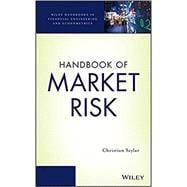A ONE-STOP GUIDE FOR THE THEORIES, APPLICATIONS, AND STATISTICAL METHODOLOGIES OF MARKET RISK
Understanding and investigating the impacts of market risk on the financial landscape is crucial in preventing crises. Written by a hedge fund specialist, the Handbook of Market Risk is the comprehensive guide to the subject of market risk.
Featuring a format that is accessible and convenient, the handbook employs numerous examples to underscore the application of the material in a real-world setting. The book starts by introducing the various methods to measure market risk while continuing to emphasize stress testing, liquidity, and interest rate implications. Covering topics intrinsic to understanding and applying market risk, the handbook features:
- An introduction to financial markets
- The historical perspective from market
- events and diverse mathematics to the
- value-at-risk
- Return and volatility estimates
- Diversification, portfolio risk, and
- efficient frontier
- The Capital Asset Pricing Model
- and the Arbitrage Pricing Theory
- The use of a fundamental
- multi-factors model
- Financial derivatives instruments
- Fixed income and interest rate risk
- Liquidity risk
- Alternative investments
- Stress testing and back testing
- Banks and Basel II/III
The Handbook of Market Risk is a must-have resource for financial engineers, quantitative analysts, regulators, risk managers in investments banks, and large-scale consultancy groups advising banks on internal systems. The handbook is also an excellent text for academics teaching postgraduate courses on financial methodology.








